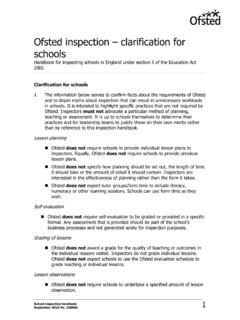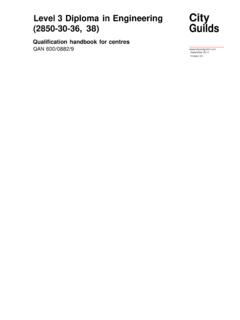Transcription of Attainment in primary schools in England - GOV.UK
1 Attainment in primary schools in England : Quality and methodology information, 04 September 2018 Contact: Email: Press office: 020 7783 8300 Public enquiries: 0370 000 2288 Attainment in primary schools in England : Quality and methodology information 04 September 2018 2 Contents 1. Introduction 3 2. About the output 3 Data sources 3 How the output is created 4 Relevance 5 Timeliness 6 Punctuality 6 3. Accuracy and reliability 7 Data coverage 7 Measurement error 10 Validation and quality assurance of source data 12 Data Processing 15 Disclosure Control 16 Reliability 17 4. Accessibility and Clarity 18 5.
2 Coherence 19 6. Comparability 21 Over time 21 Differences between school , LA and national level figures 21 Across different types of school 21 With other parts of the UK 22 International comparisons 22 7. Got a query? Like to give feedback? 22 Annex A: The national curriculum 23 Key stage 1 23 Key Stage 2 23 Phonics screening check 25 Annex B: Floor standard and coasting schools 26 Floor standard 26 Coasting schools 27 Annex C: Further detail on school characteristics 28 Annex D: Derived variables 30 Annex E: Process maps 32 Phonics 32 Key stage 1 32 Key stage 2 32 Annex F: Timeline of changes in primary assessment 33 Annex G: Glossary and abbreviations 35 3 1.
3 Introduction This document provides an overview of the data used in the production of the phonics, key stage 1 and key stage 2 statistical publication and the primary school performance tables. It provides information on the data sources, their coverage and quality and explains the methodology used in producing the data including how it is validated. It is based on the Office for National Statistics guidelines for measuring statistical quality. 2. About the output National and local authority (LA) information on Attainment of primary school pupils in England will be published in the following statistical publication in 2018.
4 Phonics screening check and key stage 1 assessments: England 2018 National curriculum assessments at key stage 2 in England , 2018 (interim) National curriculum assessments at key stage 2 in England , 2018 (provisional) National curriculum assessments at key stage 2 in England , 2018 (revised) school level information about Attainment at key stage 2 is published in the primary school performance tables. school level results for key stage 1 and phonics are not published. primary school education is split into key stages as shown in figure 1. Figure 1: Age of child related to year group and key stage Key stage 1 2 Year group R 1 2 3 4 5 6 Age of child at end of year 5 6 7 8 9 10 11 Attainment is measured by statutory assessments against the standards set out in the national curriculum at the end of each key stage.
5 In addition to assessments at the end of each key stage, pupils in year 1 also take a phonics screening check. Any year 2 pupils who did not meet the standard or did not take the phonics check in year 1, (re)-take the check in year 2. See annex A for more information on the national curriculum and statutory assessments in key stage 1 and key stage 2. Data sources Phonics State-funded schools (including academies and free schools ) are required to report pupil level phonics screening check results to their LA. The LA must then submit these results to the Department for Education (referred to from here onwards as the department ) via COLLECT (Collections On-Line for Learning, Education, Children and Teachers - a system used by the department to collect data from schools , LAs and other organisations).
6 Independent schools cannot submit phonics screening check results. 4 Key stage 1 State-funded schools are required to report KS1 teacher assessments to their LA; and the LA must then pass these results to the department via COLLECT. Independent schools and non-maintained special schools can report KS1 teacher assessments if they wish to do so. If they choose to do so, they must submit the data via their LA and meet the same conditions (for example, to be subject to LA moderation) as state-funded schools . Key stage 2 Statutory testing and assessment for pupils in primary schools is the responsibility of the Standards and Testing Agency (STA), an executive agency of the department.
7 KS2 tests must be administered by state-funded schools , the STA organises test marking and the return of results to schools . KS2 teacher assessments are also collected by STA and the information is collated and passed on within the department. Independent schools , non-maintained special schools and pupil referral units may take part in the KS2 assessments if they wish to do so. Other data The Attainment data is combined with information on pupil characteristics taken from the school census. Details of this data are provided in a separate quality and methodology document. Information on school type and phase of education are taken from Get Information About schools (GIAS).
8 Definitions are given in annex C. How the output is created Data on pupil s Attainment is collected from schools via a number of separate data collections. This information is linked with information on pupil s characteristics, school characteristics and information on pupil s prior Attainment to produce the unamended (provisional) data in the national pupil database (NPD). A number of derived variables (see annex D) are added during this process. This data is then used to produce the provisional statistical publication. Following publication of the provisional statistical publication, additional data such as that submitted after the initial deadlines or released following the completion of maladministration investigations and outcomes from KS2 marking reviews is added to the data.
9 The KS2 data is also checked with schools during the performance tables checking exercise. The revised pupil Attainment data is then linked again with information on pupil s characteristics and prior Attainment to produce the amended revised data in the NPD and all derived variables recalculated. For phonics and KS1, this data is then considered final. The final data is used to update the time series in the following year s statistical publication. For KS2 this data is published in the revised statistical publication and the performance tables. Following publication of the performance tables, there is a short errata process where schools can inform us of any additional changes that should be made to the data.
10 Following this process, the data is finalised and the NPD and the performance tables website updated. The final data is used to update the time series in the following year s statistical publication. This process for each key stage is illustrated in the process maps in annex E. 5 Relevance This section describes the degree to which the statistics meet current and potential needs of the users. Key users Department for Education Used to monitor national standards of literacy and numeracy in primary school children in England . The national figures are used to determine whether standards are improving or declining.

















